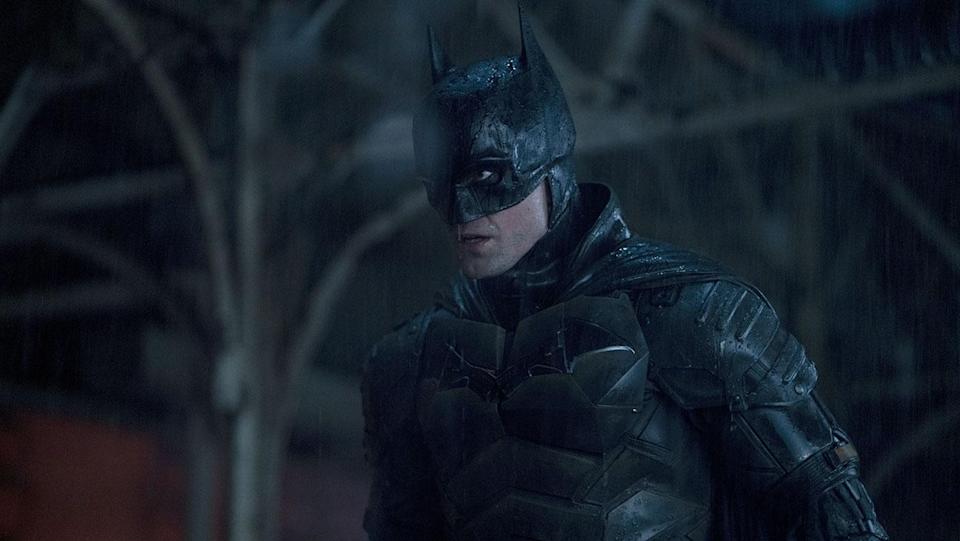
“Remember we never kill with weapons of any kind!” Those words, uttered by the Caped Crusader to his partner, Robin, in Batman No. 4 (1940) marked the debut of Batman’s “no-kill rule,” an aspect of the hero that has become almost as fundamental a character trait as his cape and cowl … in the comics at least. The film adaptations, on the other hand, have played fast and loose with that rule, with it sometimes existing as a suggestion, other times a matter of semantics, and occasionally, not existing at all. The issue of Batman’s no-killing policy is raised with every new Batman film, along with the extension of that rule — Batman doesn’t use guns, except for y’know on all his cars, tanks, motorcycles and planes. Oh, and the spear-guns, for sharks of course.
As the release of Matt Reeves’ hotly anticipated reboot, The Batman, draws nearer, once again the question of Batman’s rule is raised, and, as with most things in the superhero movie fandom, lines are being drawn in the sand, though admittedly some are deeper than others. Rather than regurgitate the same old arguments about what constitutes as killing, or make blanket statements, like “Batman never kills,” it’s more interesting to consider what it means when Batman kills, and what it means when he doesn’t, and why audiences respond the way they do in the aftermath.
More from The Hollywood Reporter
The Batman star Robert Pattinson’s recent statements about Batman’s use of lethal force have renewed the conflicting takes on Batman’s methods, especially given that this interpretation of Bruce Wayne is more mentally unstable than the previous versions. Speaking to Premiere Magazine, Pattinson said, “there is this rule with Batman: he must not kill. It can be interpreted in two ways. Either he only wants to inflict the appropriate punishment, or he wants to kill, and his self-control prevents him from doing so.”
Early reports from test screenings claim that this is a rule Pattinson’s Batman sticks to in the film and is highlighted by a specific plot point. Yet, Pattinson’s comments spawned a number of social media remarks about a Batman who kills being more “relatable,” “realistic” and “badass,” all of which are bullshit notions born of certain fans’ desire for superheroes to be taken more seriously.
These are the same fans who think jokes don’t belong in superhero films, and that a man-child with poor coping skills who dresses as a bat is the most serious business, failing to see the parodic pulp masculinity creator Frank Miller employed, intentionally or not, in The Dark Knight Returns, or the Peter Pan syndrome of a man who makes best friends with children while punching a colorful cadre of lunatics he’s too damaged to rise above, as Grant Morrison explored during their celebrated run on Batman. Within the insistence that not only should Batman kill, but that he’s right to do so, is a failure to understand why that rule was created in the first place and a deep-rooted misunderstanding of the character.
The minority of fans put off by the idea that Pattinson’s Batman won’t use lethal force will cite, without fail, the fact that in his earliest appearances, Batman did indeed kill, and that in nearly every live-action filmic portrayal of the character, from West to Affleck, and excepting Clooney, Batman has killed, a factor that rarely receives any acknowledgement within the narrative, except in Snyder’s films. But I’ll get to those films all the same in due time.
In terms of the comics, it’s clear from those early issues that writer Bob Kane and artist Bill Finger were still figuring out who Batman was, what separated him from pulp heroes like The Shadow. They were discovering what made him similar, yet still unique, to this new breed of character, the superhero, who emerged in blue and red glory with Superman. As Batman evolved, becoming a partner to the police, Batman’s killings became few and far between until one day they stopped completely. It wasn’t immediate, and even after the establishment of his rule in Batman No. 4, he still wasn’t above tossing a villain off a building or “accidentally” letting them fall to their death. But beyond simply getting a handle on the character, writers stopped Batman from killing because it depleted his rogues gallery too quickly. Comics thrived, in sales and in interest, due to familiar faces. Batman simply killing the Joker was a bad business move, and thus the storytelling developed around that.
Fredric Wertham’s psycho-babble takedown of comic books and their negative influence on children, Seduction of the Innocent (1954) put a full stop on Batman’s lethal methods, and under the Comics Code Authority, Batman became a far less violent character. The comics became much more comedic affairs, leading to the 1960s Batman TV series. As the silver age of comics gave way to the bronze age of the ’70s and ’80s, Batman once again found the dark. After he survived the changes wrought by DC’s event, Crisis on Infinite Earths, his proclivity for violence came back. But he didn’t kill outside of non-canonical Elseworld stories.
Even when it appeared Batman left his villains to die, like KG Beast in Jim Starlin and Jim Aparo’s Ten Knights of the Beast, or killed them with his own hands, like Joker in Alan Moore and Brian Bolland’s The Killing Joke, later issues showed the characters to be very much alive. The in-continuity comics, and even most of the ones outside of it, have gone through great lengths to ensure Batman doesn’t cross that line. The most noteworthy time Batman did kill — and I mean really kill, not just leave a villain to suffer the consequences of their own trap — was in Grant Morrison’s Final Crisis, in which Batman uses a Radion bullet to kill Darkseid, right before he’s killed by Darkseid’s Omega Beams. It really doesn’t get much more poetic than that — to save the world and defeat the devil, Batman has to break his own rule, and in the aftermath of committing an act so contrary to his very essence, he dies.
Warner Bros.
The films have never taken such a mythic approach to Batman’s killing, whether it be blowing up a warehouse full of Joker’s goons in Batman (1989), or blowing up the hidden fortress of the League of Shadows in order to spare a life in Batman Begins (2005), which despite Christopher Nolan’s brilliance has always been an odd point, and placed a far bigger question mark on the character’s “one rule” than letting Ra’s al Ghul (Liam Neeson) take the Gotham Express via “I won’t kill you, but I don’t have to save you.” The examples of Batman killing criminals across the films are numerous, and in 2015, YouTuber Mr. Sunday Movies released a video tallying all the times Batman killed onscreen in “Batman Movie Kill Count Supercut.” That YouTube video, ironically, was released before Zack Snyder’s Batman v Superman: Dawn of Justice (2016), which has become the biggest point of comparison regarding Batman’s no kill rule in regard to The Batman.
Now, it’s got to be said that some of the vocal minority who think Pattinson’s Batman is lesser because of his no-kill rule are offering up takes that have nothing to do with the character himself. It does however have everything to do with their inability to accept that Ben Affleck has moved on from Batman, with a small supporting role in The Flash being his farewell to the character. No amount of #MaketheBatfleckMovie trends is going to change the fact that Affleck said, numerous times, he’s moving on and the decision had just as much to do with his own health as it did his creative process. But, of course, there’s no rationalizing with people who see actors solely as deliverymen who exist to provide them the content they crave.
Affleck’s Batman will always be in conversation with Pattinson’s, just as Christian Bale’s was prior to Affleck’s casting. And undoubtedly there will be debates, years and years of them, about who was the better Batman. But here’s the thing: Affleck and Pattinson are playing profoundly different versions of the character. Although Batman’s lethal tactics and brutal methods in Batman v Superman: Dawn of Justice (2016) have been a reason why some fans gravitated toward his Batman, while others outright dismissed the characterization, there are fundamental misunderstandings on the sides of both the film’s defenders and detractors.
Warner Bros. Pictures /Courtesy Everett Collection
Affleck’s Batman, when we meet him in BvS, is not the hero. That’s a rather challenging notion for general audiences to wrap their heads around, especially coming off the nearly biblical depiction of the character in Nolan’s Dark Knight trilogy. Batman going around branding criminals, and absolutely wrecking bodies at the shipyard with his Batmobile, are not heroic acts, and the film doesn’t position them as such. Batman is the bad guy, a fact made clear by Superman’s inherent goodness leading him to make the first move and take down the Batman. Affleck’s Batman is one who is in the later days of his career, has lost hope, failed too often and retreated into a primal state, like his ancestors who were hunters. Snyder’s Batman in his last days fascinatingly mirrors the comic iteration Batman in his earliest days, 1939, existing as an unfinished version of the character. That of course changes after the death of Superman, in which Affleck’s Batman rediscovers his own humanity through the humanity displayed by an alien, and the shared trauma of two children bonded by their mothers’ first name, Martha.
Batman takes the steps to redeeming himself in Zack Snyder’s Justice League, finding “faith,” but I think it’s important to note that the character is not absolved. In fact, as detailed by Snyder’s original five-film story arc that he never completed, Batman was going to sacrifice his life in the end. If the comics are a guidebook, then a Batman who kills should be reckoned with on a thematic level and cannot be allowed to continue. There’s something to the fact that Bale and Affleck’s Batmen are both finite portrayals; their decision to kill, as Nolan’s Batman also does to Talia (Marion Cotillard) in The Dark Knight Rises (2012), leading to his retirement and passing of the mantle.
It remains to be seen where The Flash will leave Affleck’s Batman now that previous plans for the DCEU have shifted, but the presence of Michael Keaton’s Batman in that film and Batgirl does suggest Affleck’s Batman fading from existence, atoms dispersed via Omega Beams for his sins, even if only on a subtextual level. Grappling with a Batman that kills makes for an interesting affair for a character at the end of his career, as Snyder’s films and The Dark Knight Rises showcase, but for a Batman at the beginning, one with whom a filmmaker can truly take advantage of all the wonderful toys the character has to offer, his one rule could make this Batman eternal. Maybe being Batman doesn’t have to make Bruce Wayne worse; maybe it can make him better, evolve from addiction to a tool, one that doesn’t end in death, faked or otherwise, but life.
It’s clear that Reeves is building something different than what we’ve seen onscreen with Batman before. This isn’t a story simply relegated to a trilogy, or one subject to the whims and creative choices of a larger cinematic universe. Reeves is building a universe around Batman, one spanning films and HBO Max series, based around Gotham Central and Penguin. He has discussed characters, like Catwoman (Zoë Kravitz) in terms that suggest an evolution over the course of the franchise. And Reeves’ preproduction Twitter posts reference the ’60s Batman series, suggest that like those episodic narratives, his Batman will have a full cast of rogues, who are around for more than a single installment, something we haven’t seen in a Batman film, except for the Scarecrow (Cillian Murphy) in Nolan’s trilogy. Similar to the comics, by strongly enforcing Batman’s no-kill rule, Reeves allows for a scenario in which we can see a full house at Arkham Asylum and find villains like Penguin and Joker interacting, which we’ve missed out on.
But beyond franchise ambitions, a Batman who doesn’t kill isn’t forced to justify why some villains live and others don’t or get into the murky sociopolitical aspects of a guy murdering civilians in a time where police brutality is more widely discussed than ever. But most importantly, a Batman who doesn’t kill is a superhero. He’s not a gothic fairy tale, he’s not a symbol or a mere vigilante, and he’s not a villainous portrayal of post-9/11 paranoia and corruption, as he has been depicted as through Keaton, Bale and Affleck’s tenures. Pattinson’s Bruce Wayne has a chance to be better morally, to use Batman as something that lifts him up out of the darkness, rather than something that pulls him down, back to that cave he fell into as a child.
This notion, of Pattinson’s Batman emerging as the most heroic and truest to the comic character’s morality, perhaps seems odd given that Reeves’ film may be the darkest Bat-film yet. But I think all the signs are there. It’s evident in composer Michael Giacchino’s recently released theme for The Batman, which steadily rises out of the darkness and moodiness, to become something hopeful yet weighty. A Batman who kills simply cannot last, because such a contradiction cannot thrive long within a character who never wants to put another child through the violence he experienced. A Batman who kills becomes something else, and we have enough other characters to fill the void of the murderous antihero.
We’ve seen Batman lose his way in two previous franchises and watched just how low the role can take him, be it the depths of the Lazarus Pit or the death of Superman. Now, it’s time to build a better Batman, and watch him glide over the pitfalls that would see his reign end all too soon.






